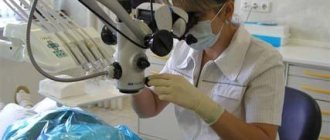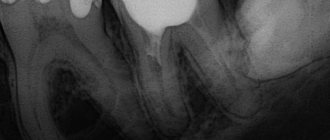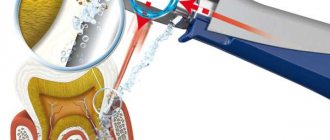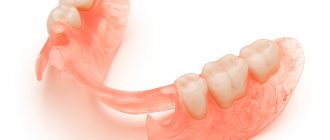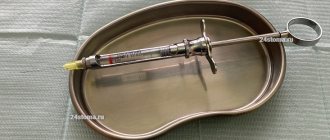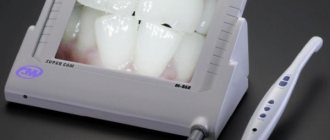Features of endodontic treatment
Since childhood, for many, going to the dentist is inevitably associated with pain. Basically, this is just a psychological factor caused by the visual perception of the dental office almost like a hospital operating room. Most dental procedures are painless thanks to a combination of advanced treatment techniques and the use of effective local anesthesia. If we talk about endodontic dental treatment, it is somewhat painful, but this, firstly, is logically explainable, and secondly, the pain will be present for a short period. When a focus of infection appears in our body, pain is a natural reaction and a signal to action. This is inherent in nature itself. In the case of endodontics, we are talking about inflamed nervous tissue, which, of course, creates unpleasant sensations. However, an experienced dentist, using high-quality anesthetics, is able to carry out all the necessary actions with minimal discomfort for you. For some time after the end of treatment, increased sensitivity of the tooth to external influences cannot be ruled out. This feature does not appear for long and is easily eliminated with available medications.
How do human teeth work?
The structure of the human tooth cannot be called complex. The visible part of the tooth (crown) is located above the gum, and inside the gum are the roots of the tooth. They serve as attachments to the jaw bones. As we said at the beginning of the article, inside the tooth there is a canal (root) containing blood vessels, as well as nervous tissue - together they are called the pulp. Thanks to nerve endings, teeth are able to signal us about the occurrence of infections or aggressive influence of external factors. The outside of the tooth is covered with a protective layer – enamel. The hard tissue of the tooth itself is called dentin. Dentin and enamel are mainly composed of mineral substances (96 and 70 percent, respectively).
Prerequisites for the disease, methods of endodontic treatment
Most often, the root cause of infection is sudden or sequential damage to the hard tissue of the tooth, as a result of which bacteria penetrate into the root cavity and inflammation of the pulp occurs. This is characterized by the occurrence of acute pain, which intensifies upon contact with cold or hot food, as well as simple touches to the tooth.
Root canal treatment in such cases is not only recommended, but also necessary, since without it, the infection begins to spread rapidly, affecting adjacent healthy teeth, as well as soft tissues. The tooth itself begins to decay. Let's consider possible dental treatment options:
— removal of the tooth (or what’s left of it) is inevitable in advanced cases, however, by starting treatment at an early stage it is possible to save it. It is worth noting that removal, although it is an effective solution, has its side effects - in particular, it can provoke deformation of the position of adjacent teeth and disruption of a healthy bite;
— tooth extraction followed by implant installation. This method reduces the negative consequences of conventional removal, however, in any situation where there is a possibility of saving a tooth, it should be used, since even the most expensive implant is not capable of becoming a 100% functional replacement of a real tooth. In addition, implant placement is an expensive procedure; in most cases, endodontic treatment, started in a timely manner, turns out to be not only preferable, but also cost-effective;
- endodontic therapy - we outlined its principle at the beginning of the article. This type of therapy is characterized by the highest degree of effectiveness, allowing you to quickly get rid of the infectious inflammatory process and maintain dental health. Depending on the degree of tooth damage and the advanced stage of the disease, treatment may take several visits (no more than three). The first step is to provide access to the root canal and clean it, followed by disinfection and filling with solution. However, if the infection is widespread, as well as the presence of several canals, repeat visits to the dentist will be required. The final step will be to install the seal. This stage is very important, since a tooth deprived of pulp (and with it a significant part of its nutrition) becomes weak, and installing a filling (and in some cases, a crown) allows it to be strengthened.
Instrument fracture in the root canal
The risk of instrument fracture is very high in case of file deformation (bending, unwinding of turns) and most often occurs when passing and expanding narrow, curved, previously sealed canals (Fig. 8). The main reasons for this complication may be the lack of adequate access to the mouth of the root canal; violation of the sequence of use of endodontic instruments; use of instruments without taking into account indications; non-compliance with operating mode and rotation speed; application of significant force during manual or machine endodontic treatment; metal fatigue caused by repeated use of the tool.
Rice. 8a. Introduction of a curved file.
Rice. 8b. Broken instrument in the root canal.
Prevention of tool breakage consists in strict adherence to the operating mode and use of the tool according to indications. The sequence of use of tools must be taken into account. During machining, the use of endolubricants is recommended.
Incomplete and insufficient obturation of the root canal is mainly due to incorrect determination of the working length, incomplete passage of the canal (Fig. 9), the use of the technique of one gutta-percha or silver pin in canals that have an oval, dumbbell-shaped, slit-like (irregular) shape that does not correspond to the shape of the pin, and also using liquid-mixed paste for filling (using a channel filler). As a result, shrinkage is inevitable, as well as dissolution of the paste some time after filling.
Rice. 9a. Obturation of root canals: high quality.
Rice. 9b. Obturation of root canals: incomplete.
The removal of filling material beyond the apical foramen is often observed after excessive mechanical treatment of the root canal. The result is destruction of the physiological apical constriction. It can also be disrupted due to a chronic inflammatory process in the tissues of the apical periodontium. In addition, there is a real possibility of removing material beyond the apex when using a machine channel filler. The risk of complications increases sharply when filling a root canal without taking into account the working length (Fig. 10).
Rice. 10. Removal of a significant volume of sealer beyond the apex.
The removal of the filling material beyond the apical foramen is observed in the case of using a large amount of sealer, as well as as a result of excess pressure during the condensation of the filling material in the root canal.
Pushing the gutta-percha pin beyond the apex may be a consequence of incorrect determination of the working length and/or incorrect selection of the size of the main pin (Fig. 11).
Rice. 11. Removing the gutta-percha pin beyond the root apex.
Removal of gutta-percha beyond the root apex is possible during the process of lateral condensation of gutta-percha (Fig. 12).
Rice. 12. Lateral condensation of pins.
Preventive measures: control of working length at all stages of endodontic treatment; competent formation of the root canal; maintaining the integrity of the anatomical (physiological) narrowing.
If removing a small amount of sealer beyond the apical foramen may not cause problems, since it is quickly resorbed, then gutta-percha removed beyond the apex, which itself is biologically inert, can maintain inflammation in the apical periodontal tissues for a long time, being a mechanical irritant.
Longitudinal root is possible during the process of lateral condensation of gutta-percha pins and is a consequence of excessive thinning of the walls of the root canal during mechanical treatment. In addition, a longitudinal root fracture can be observed with strong lateral pressure on the sprider during the condensation of gutta-percha pins.
Prevention measures include assessing the condition of the hard tissues of the tooth root, their thickness, as well as improving manual skills and applying adequate efforts in the process of condensation of gutta-percha pins.
Complications and prevention of pulp diseases
In the hands of an experienced dental surgeon, there is reason to rest in peace and confidence in a favorable outcome of treatment. After all, problems often arise due to insufficient qualifications of the doctor, ranging from incorrect diagnosis, as a result of which the problem is not fully identified and the infection continues to remain in one of the canals, ending with unprofessional installation of filling materials, due to which the infection can re-enter the canal. Unexpected damage to tooth tissue may also occur during treatment. To avoid complications (mainly in complex cases), antibiotics are prescribed in parallel with treatment.
The best prevention (besides regular visits to the dentist - at least once every six months) is simple and accessible to everyone: brushing your teeth using a suitable toothbrush and recommended toothpastes; rejection of bad habits; reducing consumption of foods high in sugar - most of these recommendations are appropriate both for the prevention of dental disease and for simply following the principles of a healthy lifestyle.
Why, in general, is it necessary to treat root canals?
The main task of an endodontist is to preserve the tooth and return it to the ability to perform its function for the maximum period. The main task of endodontic treatment is to eliminate the source of chronic infection from the tooth canals, preparing it for further restoration, i.e. The endodontist returns the tooth to service. If you do not treat a tooth with an inflamed nerve, the tooth will eventually collapse and the infection from the root canals will spread to the bone tissue surrounding the tooth, which will lead to its loss and deformation. Severely damaged teeth must be removed.
